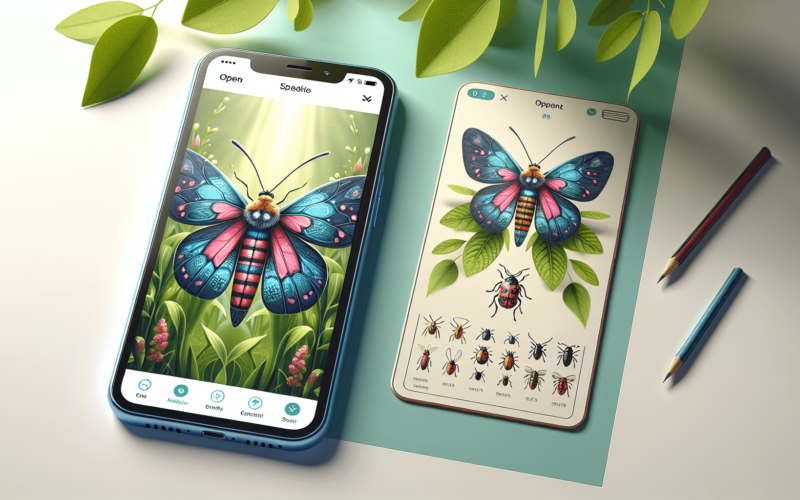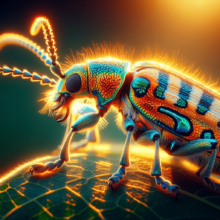Explore the fascinating world of insects and discover their shared characteristics, from their unique exoskeletons to diverse lifestyles. Uncover the commonalities!
Is There A Bug Identifying App?

Have you ever stumbled across an insect and wondered what it was?
In today’s digital world, technology offers a treasure trove of tools to help you identify everything from plants to animals. When it comes to insects, bug identifying apps have become increasingly popular. These apps not only satisfy your curiosity but also help you understand critical information about each species.
What is a Bug Identifying App?
A bug identifying app is a mobile application designed to help users recognize different types of insects. By simply snapping a photo or entering specific features, the app provides information about the insect’s species, habitat, and behavior. This is particularly useful for nature enthusiasts, gardeners, and anyone curious about the creepy-crawlies in their backyard.
Why Use a Bug Identifying App?
The benefits of using a bug identifying app are numerous. Not only do these apps satisfy your curiosity about various insects, but they also offer practical insights into pest control, ecosystem health, and biodiversity. Knowing what insects are present in your area can help you:
- Manage pests in your garden.
- Identify beneficial insects that aid in pollination.
- Learn about local biodiversity and conservation efforts.
How Do Bug Identifying Apps Work?
Generally, bug identifying apps function through a combination of image recognition technology and databases of insect information. Here’s a brief overview of the process:
Image Recognition Technology
When you take a photo of an insect, the app uses sophisticated algorithms to analyze the image. It identifies key features such as shape, color, and patterns and compares them to a vast database of insect images.
Database Comparison
Once an image is analyzed, the app cross-references the identified features with its database to find potential matches. Most apps provide a list of species that match your image, along with detailed descriptions.
User Input
Some apps also allow you to provide additional details about the insect, such as behavioral traits or habitat, to increase the accuracy of the identification.
Popular Bug Identifying Apps
There are numerous bug-identifying apps available for both Android and iOS devices. Below are some popular options for you to consider.
| App Name | Key Features | Pricing |
|---|---|---|
| iNaturalist | Community support, wide database of species | Free |
| Picture Insect | User-friendly interface, detailed information | Free with ads |
| Seek by iNaturalist | Educational features, gamified challenges | Free |
| BugGuide | Community-driven, extensive bug resources | Free |
| PlantSnap | Works for plants, helps identify insects too | Free with ads |
iNaturalist
iNaturalist is more than just a bug identification app; it’s a community of nature enthusiasts. When you upload a picture of an insect, other users can help you with identification. This social aspect makes it a great way to learn and connect with others who share your interest in nature.
Picture Insect
Picture Insect is designed to be user-friendly, making it an excellent option for those new to insect identification. You simply snap a photo, and it provides instant identification along with information about the insect’s lifecycle and habitat.
Seek by iNaturalist
Seek is a fun, educational app that encourages you to identify as many species as you can. As you identify insects and plants, you earn badges in the app, making learning about biodiversity a fun challenge.
BugGuide
BugGuide is unique because it relies heavily on the contributions of community members who share their insect photographs. It has a massive database, making it a reliable resource for anyone interested in bugs.
PlantSnap
Though primarily focused on plant identification, PlantSnap also allows users to identify insects associated with those plants. This makes it a valuable tool for gardeners and outdoor adventurers alike.

What to Look for in a Bug Identifying App
When selecting a bug identifying app, consider the following features to ensure that it meets your needs:
User Accessibility
The app should be easy to navigate, with a straightforward layout that allows you to take pictures and access information without any problems.
Database Size
A more extensive database generally means better identification accuracy. Look for apps that boast a large collection of insects, as they are more likely to provide you with precise results.
Community Support
Some of the best apps have strong community backing, enabling users to learn from one another. Features like forums or user contributions can enhance the learning experience.
Offline Capability
If you plan on venturing into the wilderness without cell service, consider an app that offers offline access. This ensures that you can still identify bugs even without a strong internet connection.
Regular Updates
Insects are continually being classified and studied, so it’s helpful if the app receives regular updates to its database. Check for a developer that is active and committed to providing users with the latest information.
Limitations of Bug Identifying Apps
While bug identifying apps are great resources, they are not infallible. Here are some limitations to keep in mind:
Identification Accuracy
No app can guarantee 100% accuracy. Insect identification often requires a detailed examination of features, and apps may misidentify species, especially if the image quality isn’t high.
Environmental Factors
Different insects can appear quite different based on factors such as lighting, habitat, and stage of life. An app may struggle to identify an insect if these variables are not accounted for.
Species Variety
Some regions are home to an abundance of insects, making it challenging for even the best app to catalog every single one. This can lead to missed identifications for less common species.
Tips for Effective Bug Identification Using Apps
To enhance your experience with bug identifying apps and improve identification accuracy, keep these tips in mind:
Take Clear Photos
A clear image increases the chances of accurate identification. Make sure your camera is focused, and try to capture the insect from multiple angles to show different features.
Observe Behavior
Take notes on the insect’s behavior and habitat. This extra information can significantly help in identifying the species, as some apps allow you to input these details.
Compare Multiple Sources
If you’re unsure about an identification result, consider checking other apps or online databases to confirm identification. Gathering information from various sources improves reliability.
Engage with the Community
Many apps have user communities or forums. Connect with other users to discuss your findings, get insights, or learn more about bugs in your area.
Respect the Insect
While curiosity is natural, always be respectful of insects and their habitats. Avoid harming them for photographs, and remember that many insects play crucial roles in ecosystems.
Potential Real-World Applications
Identifying insects isn’t just a fun hobby; it also has practical applications in various fields:
Agriculture
Farmers can benefit from bug identification apps to monitor pest populations in crops. Knowing whether an insect is harmful or beneficial allows for informed pest management decisions, increasing overall crop health.
Education
Teachers and students can use these apps as educational tools to learn about entomology and local ecosystems. They offer an interactive way to engage with nature.
Environmental Monitoring
Ecologists can utilize these apps to track insect populations and monitor biodiversity in specific areas. This data is vital for conservation efforts and understanding ecological changes.
The Future of Bug Identification Technology
As technology continues to advance, so will the capabilities of bug identifying apps. Future developments might include:
Enhanced Algorithms
Expect to see improved algorithms that can identify insects with even greater accuracy. With the integration of machine learning, apps could learn and adapt from user inputs over time.
Augmented Reality (AR)
Imagine being able to point your smartphone camera at an insect, and seeing tons of information about it overlayed in real-time through augmented reality. This future could offer even more interactive learning experiences.
Community Engagement
Increased community functionality will likely become more prevalent. Collaborative features such as live insect sightings or species mapping could enrich the user experience.
Broader Database Integration
As existing databases collaborate, you can look forward to apps featuring expansive insect catalogs that incorporate information from researchers around the globe.
Conclusion
In a world filled with so many fascinating creatures, bug identifying apps act as handy tools to nurture your curiosity and broaden your knowledge. Whether you’re a gardening enthusiast, an outdoor adventurer, or simply someone who loves nature, these apps offer valuable information at your fingertips.
So, the next time you encounter a curious insect, you’ll be well-prepared to find out exactly who it is. With a quality bug identifying app, the world of insects becomes a little more accessible—and a whole lot more interesting. Happy identifying!



